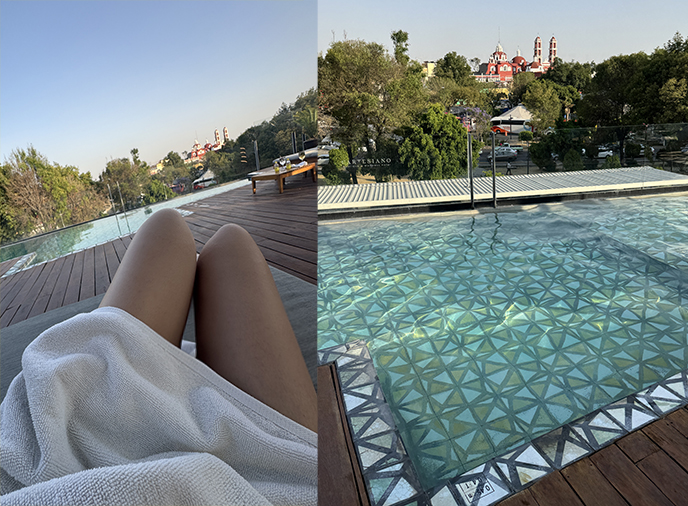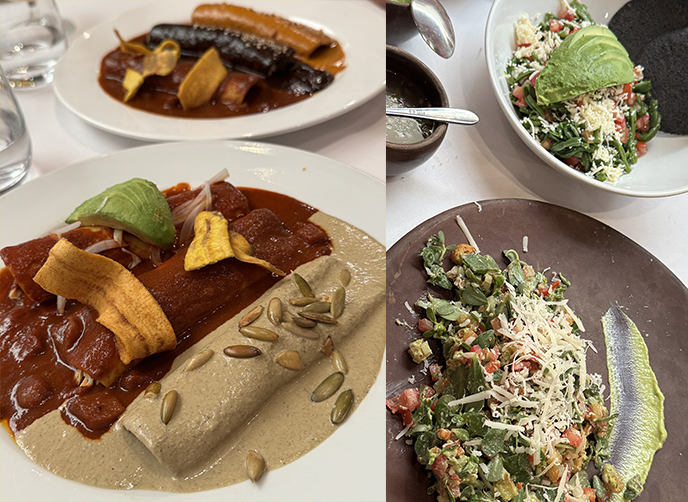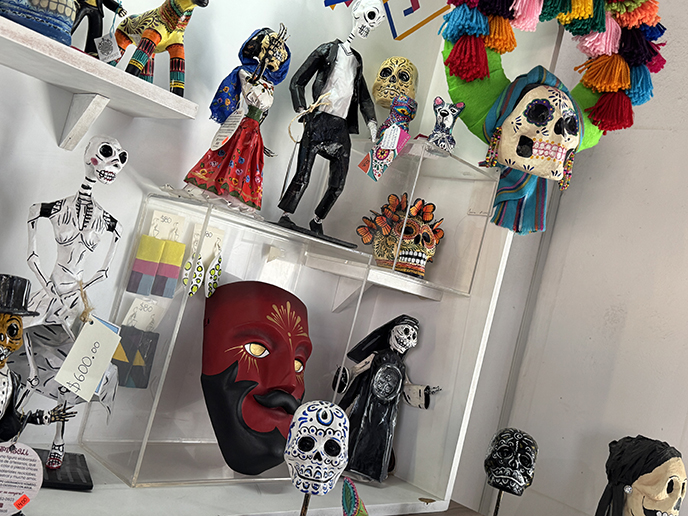Puebla, Mexico travel guide! Toyo Ito’s Museo Barroco architecture, talavera skull art, artisan shops & restaurants.

I’m back from Mexico now… and had the most magnificent time in Puebla! Only a two hour drive from Mexico City, Puebla is a peaceful artisan and food city famed for its Baroque buildings…
… as well as this masterwork of Japanese minimalist architecture (above): Toyo Ito’s Baroque art museum, Museo Internacional del Barroco!

Read on for my food / art / shopping guide to Puebla, Mexico. My favorite mems include strolling around the artist markets, eating street foods like quesadillas and tacos, and chilling poolside at Cartesiano spa wellness hotel overlooking the old Catedral. (Gracias Canirac Nacional and our new friends Maria and Miguel for making these travel experiences possible.)

Puebla is only a two hour car ride from CDMX, making it a sweet escape from hectic city life for a few days.

Treat yourself to a stay at Cartesiano Boutique & Wellness Hotel like I did. You get access to spa facilities and a quiet rooftop pool overlooking this colonial era church.

Cartesiano Hotel is located in a former convent and has a stunning garden with a labyrinth! Guests can take part in free wellness classes; we loved trying a morning moving meditation session.

Puebla’s colorful streets have a unique feel because of its history. The Spanish founded the city in 1531, and the architecture is a mix of European Baroque and Indigenous styles. Puebla is also the only major colonial city in Mexico that was not built at the site of a pre-Columbian settlement.

Puebla is also home to a masterpiece of Japanese minimalist architecture… Museo Internacional del Barroco! Architect Toyo Ito’s design looks like curved white concrete sails mirrored by water — a contemporary take on the 17th century art displayed inside.

Built in 2016, the Baroque International Museum’s maze of rooms highlights the contrast of light and dark (chiaroscuro) that fascinated Baroque artists.
Watch my IG video to see me exploring Toyo Ito’s architecture!

A swirling courtyard fountain mimics the dramatic flow of water found in many 17th century works.

I was enthralled by Toyo Ito’s use of light and curved concrete elements.

Inside the museum, you can see works of art by Pueblan artists, as well as impressive collections of Baroque works.

Come at golden hour and stay until evening to see the white sails aglow.

The whirlpool in the center of the courtyard is mesmerising — possibly my favorite space in the museum.

Toyo Ito’s wave-like shapes also pay homage to Italian architect Francesco Borromini’s facades.

Museo Barroco in Puebla is a must for those who love classic art and Japanese minimalism.

The moon came out to play… At night, the structures are illuminated with light.

I’m so happy I got to see Toyo Ito’s Baroque museum in Puebla. Check out my Instagram @lacarmina reel for a walk-through of the architecture.

I worked up an appetite, so it was taco time. Maria took us to her favorite street vendors — and Taqueria Las Ahumaderas served one of the absolute best tacos I’ve ever had.
See how the chef “werked” the grill with a hairdryer! The chopped beef was melt-in-your-mouth juicy, topped with guacamole and salsa… I could have eaten six of these carne asada tacos.

We also tried pork carnitas tacos and unique Pueblan versions, arabes and orientale (pork with Middle Eastern spices, served in pita bread).

The next day, we headed to Mercado Cholula (located near Cholula Pyramid, the largest in the world by volume). Here I had the best quesadilla of my life: a freshly made blue corn tortilla with stringy cheese, squash blossoms and huitlacoche truffles!

Cholula Market is a well-run and friendly place to try local specialties like stews and memelas poblanas (thicker masa tortillas with beans and other toppings).

You can also shop for all types of produce and ingredients, as well as healing herbs — I left with a sachet of Mexican oregano. The friendly vendors hold out samples for you to taste: Puebla’s yellow peaches were scrumptious!

One of the reasons I wanted to visit Puebla was for its famous talavera, a pottery tradition that dates back to the mid 16th century.

You can purchase talavera at various shops and markets in the city, but I wanted to visit one of the most well-regarded producers: Talavera de la Reyna, not far from Cholula Market.
I knew I was in the right place as soon as I saw this wall of black and white skulls!

My goal was to purchase a Mexican talavera skull for my apartment redecoration project (which I will reveal soon). So many one-of-a-kind handmade skulls to choose from…

Talavera de la Reyna has the highest quality ceramics, from sculptures to plates and vases. The elaborate process includes two kiln firings and hand painting, and can take months to complete.

Of course, I had to take home one of the skulls (a tribute to Mexican Day of the Dead culture) – can you guess which one?

If you visit Puebla, you can’t miss Talavera de la Reyna’s showroom and art gallery. There’s no better place to learn about the ancient ceramic tradition and find an original piece.

I’m all about hands-on activities, and was delighted to take a Mexican cooking lesson. I learned how to make mole poblano from scratch using pre-Hispanic methods in the home of Maria and Miguel’s mother! We gathered in her classic kitchen and prepped a dozen ingredients for the spicy, earthy, chocolate-y sauce, which is one of my favorite Mexican foods. A delight to then share the mole with their family along with Pueblan dishes like chalupas (a crisp tortilla with toppings).

We also had a meal to remember at El Mural de los Poblanos, known as the best traditional restaurant in Puebla. How lovely is this open space with a mural and skylight.

I devoured three types of mole on duck enchiladas, as well as fresh salads made with papalo, a peppery green leaf from this region.

I came across a witchcraft themed cafe as well, Home Witch Home, which is done up in Halloween decor for “foolish mortals.”

More authentic are the smiling sugar skulls and La Catrinas found at Perros del Mal, a buzzing mezcal bar with an impressive selection of mezcals, including artisanal versions from the Puebla area.

I had a mezcal cocktail in a talavera skull mug and shared modern Mexican plates at Attico 303, a hip restaurant in the historic district overlooking the grand Catedral de Puebla (a UNESCO heritage site). The perfect spot for dinner with a view of the central plaza.

You can’t leave Puebla without doing some serious shopping. I dropped pesos at La Cosmetiqueria, an all-natural soap and skincare store near the historic center. I found snake and pumpkin soaps for less than a dollar each (perfect gifts for Goths) and got a creamy avocado moisturizer.

“You can sit with us,” Puebla Goth edition! While there aren’t really any Gothic attractions here, you’ll find friendly skeletons all throughout the city.

I browsed the many market stalls that sold art and souvenirs, but preferred the higher quality items found in artisan boutiques, particularly in the Barrio del Artista (Artist Quarter).

Dancing calaveras and devil masks — Mexican culture has plenty of spooky elements!

My face looked like these happy skulls as I wandered around the small artisan workshops and saw them at work in the Artist’s Barrio.

Don’t you want to visit Puebla, Mexico after seeing how my trip went down? Gracias to everyone who made these travels possible. (Please click on the Puebla story highlight on my Instagram @lacarmina for more tips!)

I leave you with rainbow sugar skulls and a few press / writing updates.
Huffington Post interviewed me about travel JOMO, or the joy of missing out when on vacation. I told them: “I’m a fan of the Chinese ‘lying flat’ movement, which is about living simply and opting out of the socially conditioned trappings of hustle and work culture.” Read more of my thoughts on Huffington Post.
WIRED Magazine also interviewed this Goth gal about how to keep up a skincare / beauty routine while traveling! Of course, I went on about sun protection… See the article “How to Pack Your Beauty Routine for Travel” on Wired.

Finally, I received an assignment to write Eater’s Best Restaurants guide to Osaka, Japan. See all my food and travel writing for Eater national here. Thanks for supporting my journalism, and as always, you can catch up on my current travels and fixations on IG @LaCarmina!
SHARE & COMMENT

 LA CARMINA
LA CARMINA







14 Comments
That scenery is absolutely breathtaking, it look’s so peaceful and relaxing. Love the swirling courtyard fountain, of course i’d want to visit Puebla Mexico it look’s like paradise on earth. Very nice blog post, love your writing style and photos. Always a pleasure reading new blog post.
Ah, wish I were back there – it’s such a relaxing and artistic city, perfect for strolling around to see art and eat street food! Thank you and hope you get to go!
Thank you for sharing.
My pleasure! More from Mexico to come.
Sounds like an amazing trip Puebla is now on my bucket list. Loved hearing about the art and food scenes. Inspired to pack my bags and of course stylish shirts are a must for travel like that.
Wow, Puebla looks so beautiful. The mix of art, food and peaceful vibes sounds like the perfect getaway. I love how you described the markets and architecture so inspiring.
Loving the content shared from your side.
Sounds like an unforgettable trip. Puebla’s mix of culture, food and design is amazing perfect backdrop for some travel style too. Now I am daydreaming about planning my own getaway hopefully timed with a ready to wear sale.
Thank you for sharing!
Puebla sounds like a dream art, architecture and food all in one place It is funny how inspiration shows up everywhere even made me think how the flow of Baroque design mirrors the elegance and strength
Such a vibrant and unique travel experience. The colors and textures so much cultural inspiration here.
Such a fascinating glimpse into Puebla culture and architecture. I could not help but notice how some of the local jewelry designs would make beautiful earrings for girls the intricate details and vibrant colors truly reflect the region’s rich artistic heritage.
oh for sure! I got a talavera necklace as it was perfect for the designs!
Loved this deep dive into Puebla’s vibrant culture and design. Now craving pan dulce from a local bakery nothing beats discovering a city through its pastries.